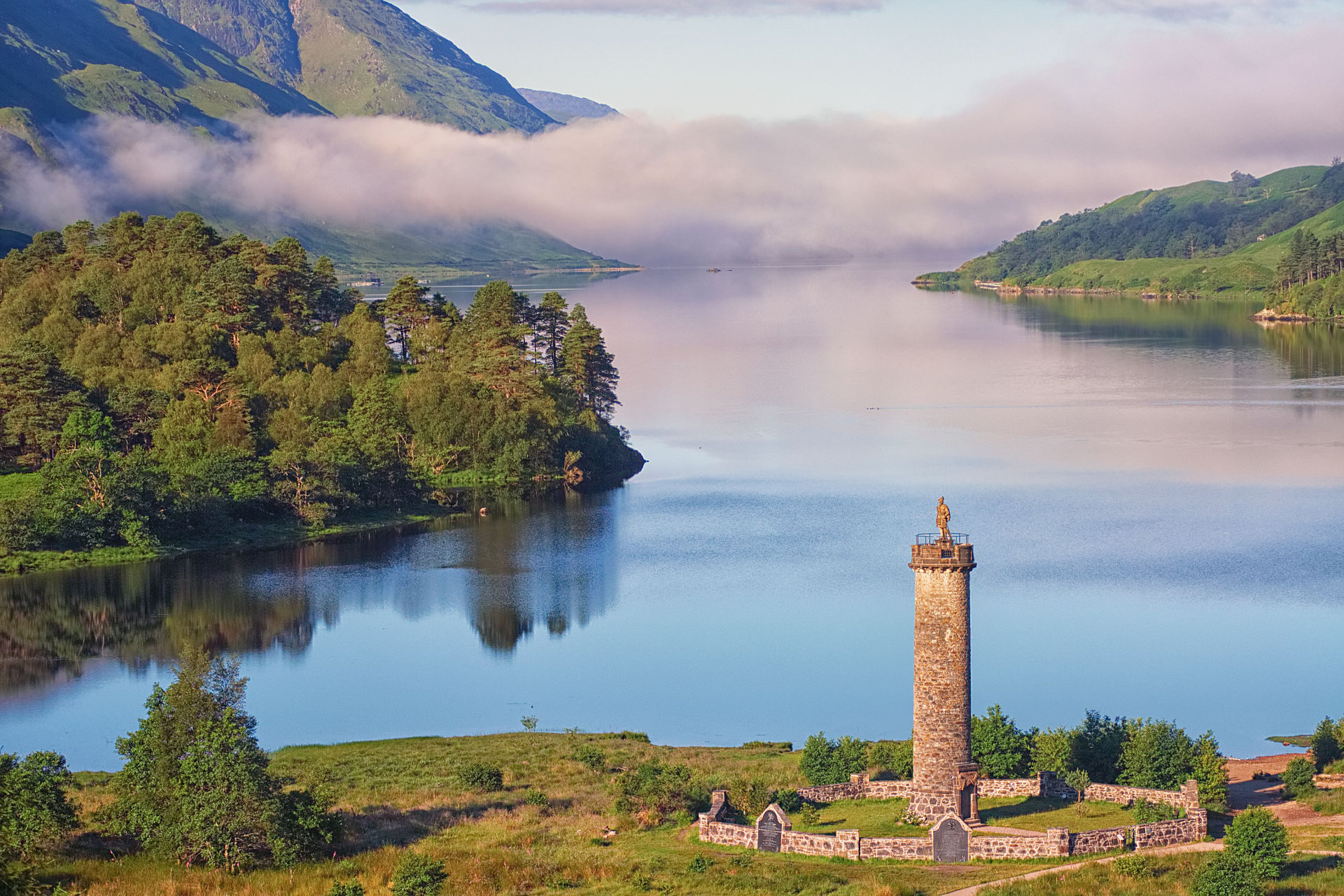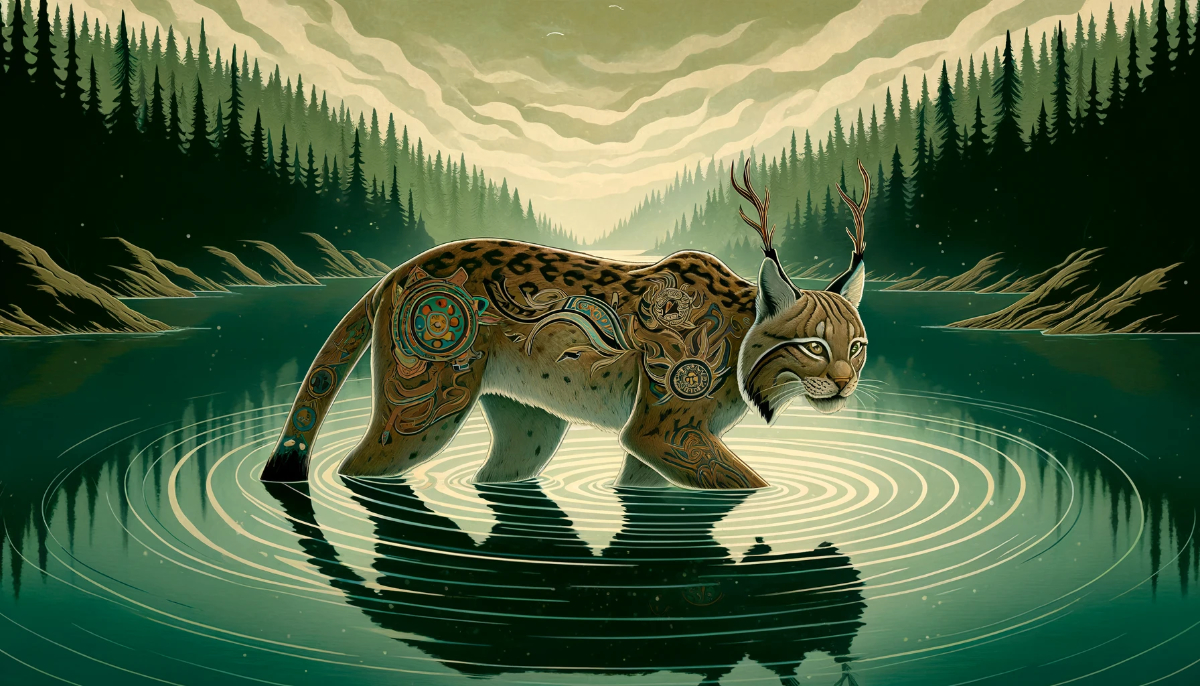In Ojibwa mythology, few figures command as much reverence and mystery as Mishipeshu—the Great Lynx. This powerful water spirit, dwelling in the depths of the Great Lakes, embodies the might and unpredictability of these vast inland seas. For the Ojibwa people, whose lives were intimately connected to the rivers and lakes of the Great Lakes region, Mishipeshu held a central place in their spiritual worldview, their understanding of nature, and their relationship with water.
The Great Lynx: More Than Legend
The name Mishipeshu translates to “the Great Lynx,” but this being far exceeds any ordinary lynx. Traditional accounts describe Mishipeshu as a hybrid creature combining feline grace with reptilian ferocity. Artistic depictions show it adorned with scales, horns, sharp claws, and a serpentine tail. Some traditions describe its body as shimmering with copper and gold, reflecting its deep association with the waters and mineral wealth of the region.
Mishipeshu is said to dwell in the depths of lakes and rivers, particularly in areas with underwater copper deposits. The creature guards these sacred waters and their resources, maintaining balance between the human world and the natural forces that govern the lakes. Its presence manifests in the ripple of waves, the roar of rapids, and the eerie calm that sometimes settles over deep water at dusk.
Unlike Western monster narratives that portray creatures as simply threatening or benign, Mishipeshu embodies the Great Lakes’ dual nature: a source of sustenance and transportation, yet capable of sudden violence. The creature represents water’s complexity—life-giving and potentially deadly, generous and demanding respect in equal measure.
Guardian of Waters and Copper
For the Ojibwa people, water held profound spiritual significance. Rivers and lakes weren’t merely resources but living entities deserving respect and proper relationship. Mishipeshu served as the ultimate guardian of these waters, ensuring they received appropriate reverence from those who used them.
Travelers on the Great Lakes often left offerings before embarking on journeys, seeking Mishipeshu’s blessing for safe passage. Fishermen acknowledged the spirit before casting nets, recognizing that the lake’s bounty came with responsibilities. These weren’t superstitious rituals but expressions of a worldview that understood humans as participants in—not masters of—natural systems.
Mishipeshu’s association with copper held particular importance. The Great Lakes region contains rich copper deposits, and indigenous peoples mined and worked copper for millennia before European contact. Traditional accounts describe Mishipeshu as the fierce guardian of these underwater copper veins. Those who sought copper without proper respect and ceremony risked the spirit’s wrath, often manifested through storms, drownings, or mysterious disappearances.
This connection between water spirit and mineral resources reflects sophisticated understanding of geology and ecology. Copper deposits often occur along lakeshores and riverbeds, and their extraction required entering Mishipeshu’s domain. The spiritual framework ensured sustainable practices—copper was taken with reverence, in appropriate amounts, and with full awareness of the responsibility involved.
Oral Traditions and Cultural Teaching
Ojibwa oral traditions preserve numerous stories about Mishipeshu, each carrying lessons about respect, balance, and proper relationship with nature. These narratives served multiple purposes: entertainment, cultural preservation, moral instruction, and the transmission of practical knowledge about navigating dangerous waters.
Many stories emphasize Mishipeshu’s role as both protector and test. Warriors and travelers who demonstrated humility and respect for water might earn the spirit’s favor, receiving safe passage or even assistance in times of need. Those who approached the lakes with arrogance or greed faced harsh lessons about the limits of human power.
Some accounts describe individuals who caught glimpses of Mishipeshu’s shimmering form just beneath the water’s surface. These encounters were interpreted as warnings, blessings, or messages, depending on the circumstances and the observer’s relationship with the water. Elders used these stories to teach younger generations about reading water conditions, understanding weather patterns, and recognizing when the lakes became too dangerous for travel.
The Great Lynx also appears in creation narratives and stories explaining natural phenomena. Storm-driven waves might be attributed to Mishipeshu’s movement through deep water. Sudden calms could indicate the spirit’s watchful presence. Successful fishing or safe journeys were sometimes credited to proper acknowledgment of Mishipeshu’s guardianship.
Artistic Representations
Mishipeshu features prominently in Ojibwa art, from traditional birchbark scrolls to rock paintings found along Great Lakes shorelines. These depictions often show the creature with distinctive features: a long tail, horns or spikes along the back, scales or spotted hide, and sharp teeth or claws.
Pictographs at sites like Agawa Rock on Lake Superior preserve ancient images of Mishipeshu, some estimated to be centuries old. These rock paintings occupy significant spiritual sites, often in locations where the lakes demonstrate particular power or danger. The placement of these images wasn’t random—they marked places where Mishipeshu’s presence felt especially strong, where proper respect became most crucial.
Contemporary Ojibwa artists continue depicting Mishipeshu, maintaining the tradition while sometimes incorporating modern materials and techniques. These artworks serve multiple purposes: preserving cultural heritage, educating non-indigenous audiences about Ojibwa spirituality, and asserting ongoing connection to traditional lands and waters.
Spiritual Significance and Ceremony
Mishipeshu occupied a central place in Ojibwa spiritual practices related to water. Before significant undertakings—long journeys, copper mining, or fishing expeditions—ceremonies acknowledged the Great Lynx and sought harmonious relationship with the water spirits.
These weren’t simple prayers or superstitious gestures but complex ritual frameworks ensuring that human activities remained in balance with natural systems. Tobacco offerings, songs, and specific protocols demonstrated understanding that accessing lake resources required reciprocity and respect.
The Midewiwin (Grand Medicine Society) incorporated Mishipeshu into their spiritual teachings. The creature represented one aspect of the complex spiritual forces that governed the natural world. Understanding Mishipeshu meant understanding proper relationship with water, respect for nature’s power, and recognition of human dependence on forces beyond our control.
Cultural Continuity and Modern Relevance
Contemporary Ojibwa communities continue honoring Mishipeshu as part of their living spiritual heritage. Stories pass between generations, ensuring that traditional knowledge and cultural values survive. While some practices have evolved, the core understanding of Mishipeshu as water guardian persists.
In Monsters and Us: Unveiling North America’s Cryptid Mysteries, I explore how indigenous water spirit traditions like Mishipeshu differ fundamentally from Western cryptid narratives. Where cryptozoology seeks to prove or disprove physical existence, indigenous traditions maintain spiritual and cultural truths that transcend biological categorization.
Mishipeshu’s story carries particular relevance in our current environmental moment. The Great Lakes face numerous challenges: pollution, invasive species, climate change, and overuse. Mishipeshu’s role as guardian and the indigenous emphasis on respectful relationship with water offer valuable perspectives on environmental stewardship.
The creature reminds us that water demands respect, that resources come with responsibilities, and that sustainable practices require understanding our dependence on natural systems. These aren’t merely quaint traditional beliefs but sophisticated ecological knowledge wrapped in spiritual narrative.
Respecting Cultural Heritage
It’s important to recognize that Mishipeshu belongs to Ojibwa cultural and spiritual traditions. While sharing these stories serves educational purposes, they should be approached with respect for their origins and meanings. Mishipeshu isn’t a cryptid to be hunted or a mystery to be solved—it’s a sacred being within a living spiritual tradition.
Non-indigenous people interested in Mishipeshu should engage respectfully with Ojibwa communities, recognize the cultural context of these traditions, and understand that some knowledge may not be appropriate for sharing outside specific cultural frameworks. Indigenous peoples maintain the right to determine how their spiritual beliefs and cultural knowledge are discussed and represented.
The Lessons of the Great Lynx
Mishipeshu teaches profound lessons about humanity’s relationship with nature. The Great Lynx represents water as a living force deserving respect, resources as gifts requiring reciprocity, and nature as powerful beyond human control. These teachings, preserved through centuries of oral tradition, offer wisdom relevant to contemporary environmental challenges.
The creature also demonstrates how indigenous knowledge systems preserved practical information through spiritual narratives. Stories about Mishipeshu taught children to respect dangerous waters, warned adults about treacherous conditions, and ensured that resource extraction occurred sustainably and reverently.
In our modern context, with the Great Lakes and other water systems facing unprecedented pressures, Mishipeshu’s message resonates powerfully. The water guardian reminds us that these vast lakes aren’t merely resources to exploit but living systems requiring careful stewardship, that accessing nature’s gifts carries responsibilities, and that our relationship with water must be one of respect rather than domination.
The Great Lynx may dwell beneath the surface, but its lessons ripple outward, inspiring reflection on how we relate to the natural world, how we pass knowledge between generations, and how spiritual traditions preserve essential truths about our place in nature.
For deeper exploration of Mishipeshu and other indigenous traditions surrounding North American cryptids and water spirits, discover Monsters and Us: Unveiling North America’s Cryptid Mysteries. The book examines these powerful beings not as mysteries to solve but as cultural treasures offering profound insights into human relationships with the natural world.
Related Articles

The Squonk: America's Most Melancholy Cryptid
Discover the tale of Pennsylvania's weeping forest creature, a unique cryptid that captures hearts with its melancholic charm.

Lake Monsters: The Hidden Giants of North American Waters
From Lake Champlain to Okanagan Lake, exploring the legends of mysterious creatures lurking in the depths of North America's lakes.
